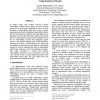Free Online Productivity Tools
i2Speak
i2Symbol
i2OCR
iTex2Img
iWeb2Print
iWeb2Shot
i2Type
iPdf2Split
iPdf2Merge
i2Bopomofo
i2Arabic
i2Style
i2Image
i2PDF
iLatex2Rtf
Sci2ools
IPPS
2007
IEEE
2007
IEEE
Security Threat Prediction in a Local Area Network Using Statistical Model
In today’s large and complex network scenario vulnerability scanners play a major role from security perspective by proactively identifying the known security problems or vulnerabilities that exists across a typical organizational network. Identifying vulnerabilities before they can be exploited by malicious user often helps to test, maintain, and assess the risk of the existing network. Still there are many problems with currently available state of the art vulnerability scanners like hampering system resource. One possible solution to this problem might be reducing the number of vulnerability scans, along with the quantitative approach towards different vulnerability category in order to identify which class of vulnerability should enjoy preference in the risk mitigation procedure. This paper introduces a model that predicts vulnerabilities that will occur in near future on a Local Area Network (LAN) by using statistical measures and vulnerability history data. Two case studies ha...
Distributed And Parallel Computing | IPPS 2007 | Network Scenario Vulnerability | Vulnerability | Vulnerability Scanners |
| Added | 03 Jun 2010 |
| Updated | 03 Jun 2010 |
| Type | Conference |
| Year | 2007 |
| Where | IPPS |
| Authors | Somak Bhattacharya, S. K. Ghosh |
Comments (0)

